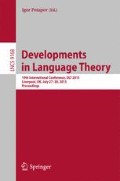Abstract
We consider several language-theoretic aspects of unique factorization in formal languages. We reprove the familiar fact that the set uf(L) of words having unique factorization into elements of L is regular if L is regular, and from this deduce an quadratic upper and lower bound on the length of the shortest word not in uf(L). We observe that uf(L) need not be context-free if L is context-free.
Next, we consider some variations on unique factorization. We define a notion of “semi-unique” factorization, where every factorization has the same number of terms, and show that, if L is regular or even finite, the set of words having such a factorization need not be context-free. Finally, we consider additional variations, such as unique factorization “up to permutation” and “up to subset”. Although all these variations have been considered before, it appears that the languages of words having these properties have not been positioned in the Chomsky hierarchy up to now. We also consider the length of the shortest word not having the desired property.
Access this chapter
Tax calculation will be finalised at checkout
Purchases are for personal use only
Preview
Unable to display preview. Download preview PDF.
References
Berstel, J., Perrin, D., Reutenauer, C.: Codes and automata. In: Encyclopedia of Mathematics and its Applications, vol. 129. Cambridge University Press (2010)
Blanchet-Sadri, F., Morgan, C.: Multiset and set decipherable codes. Computers and Mathematics with Applications 41, 1257–1262 (2001)
Burderi, F., Restivo, A.: Coding partitions. Discrete Mathematics and Theoretical Computer Science 9, 227–240 (2007)
Head, T., Weber, A.: Deciding code related properties by means of finite transducers. In: Capocelli, R., De Santis, A., Vaccaro, U. (Eds.) Sequences II: Methods in Communication, Security, and Computer Science, pp. 260–272. Springer (1993)
Head, T., Weber, A.: Deciding multiset decipherability. IEEE Trans. Info. Theory 41, 291–297 (1995)
Hopcroft, J.E., Ullman, J.D.: Introduction to Automata Theory, Languages, and Computation. Addison-Wesley (1979)
Immerman, N.: Nondeterministic space is closed under complementation. SIAM J. Comput. 17, 935–938 (1988)
Jürgensen, H., Konstantinidis, S.: Codes. In: Rozenberg, G., Salomaa, A. (Eds.) Handbook of Formal Languages, Word, Language, Grammar, vol. 1, pp. 511–607. Springer (1991)
Lempel, A.: On multiset decipherable codes. IEEE Trans. Info. Theory 32, 714–716 (1986)
Rampersad, N., Shallit, J., Wang, M.-W.: Inverse star, borders, and palstars. Info. Proc. Letters 111, 420–422 (2011)
Restivo, A.: A note on multiset decipherable codes. IEEE Trans. Info. Theory 35, 662–663 (1989)
Shallit, J.: A Second Course in Formal Languages and Automata Theory. Cambridge University Press (2009)
Szelepcsényi, R.: The method of forcing for nondeterministic automata. Bull. EATCS 33, 96–100 (1987)
Weber, A., Head, T.: The finest homophonic partition and related code concepts. In: Privara, I., Ružička, P., Rovan, B. (eds.) MFCS 1994. LNCS, vol. 841, pp. 618–628. Springer, Heidelberg (1994)
Zhang, G.-Q.: Automata, Boolean matrices, and ultimate periodicity. Inf. Comput. 152, 138–154 (1999)
Author information
Authors and Affiliations
Corresponding author
Editor information
Editors and Affiliations
Rights and permissions
Copyright information
© 2015 Springer International Publishing Switzerland
About this paper
Cite this paper
Bell, P.C., Reidenbach, D., Shallit, J. (2015). Factorization in Formal Languages. In: Potapov, I. (eds) Developments in Language Theory. DLT 2015. Lecture Notes in Computer Science(), vol 9168. Springer, Cham. https://doi.org/10.1007/978-3-319-21500-6_7
Download citation
DOI: https://doi.org/10.1007/978-3-319-21500-6_7
Published:
Publisher Name: Springer, Cham
Print ISBN: 978-3-319-21499-3
Online ISBN: 978-3-319-21500-6
eBook Packages: Computer ScienceComputer Science (R0)

